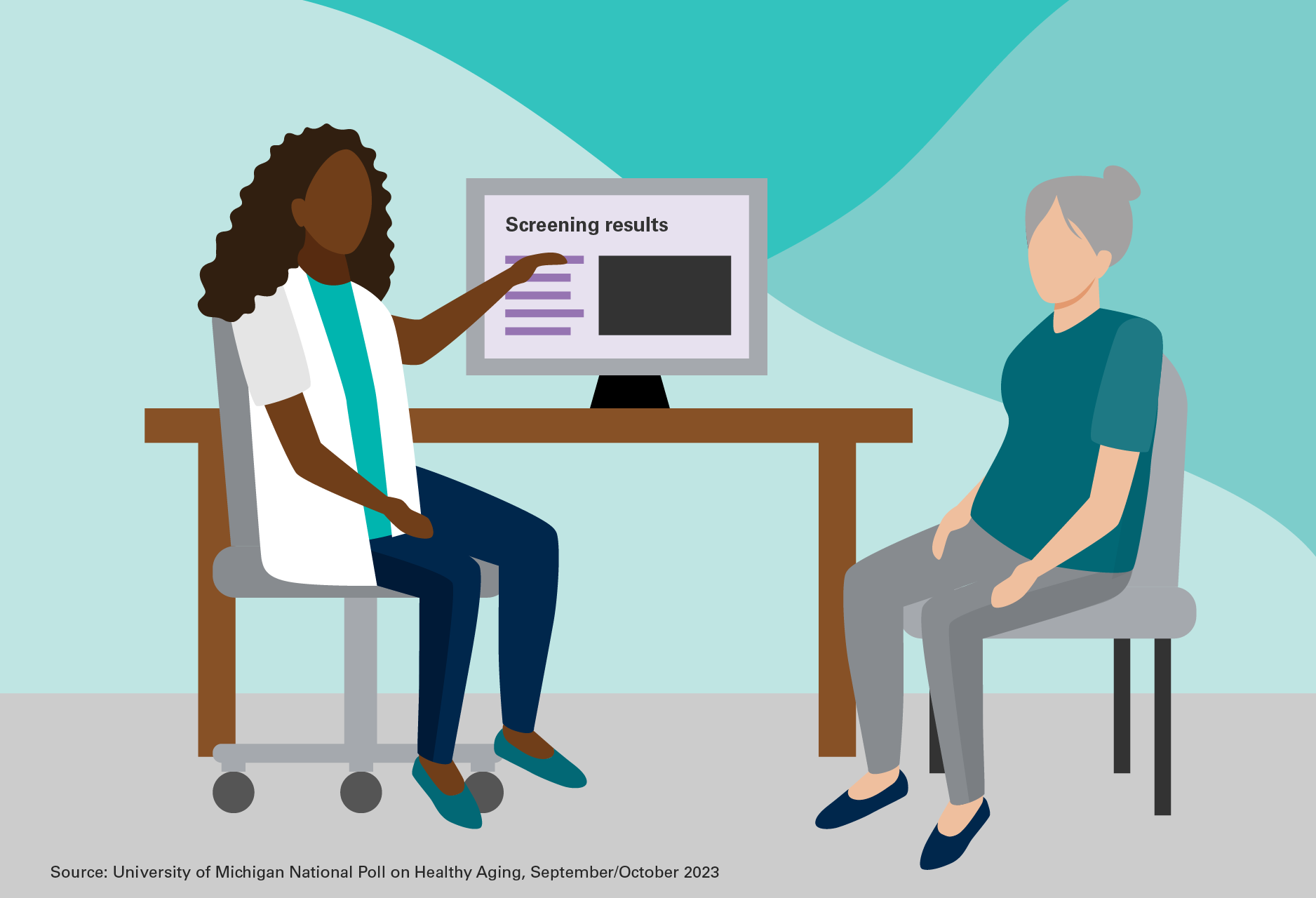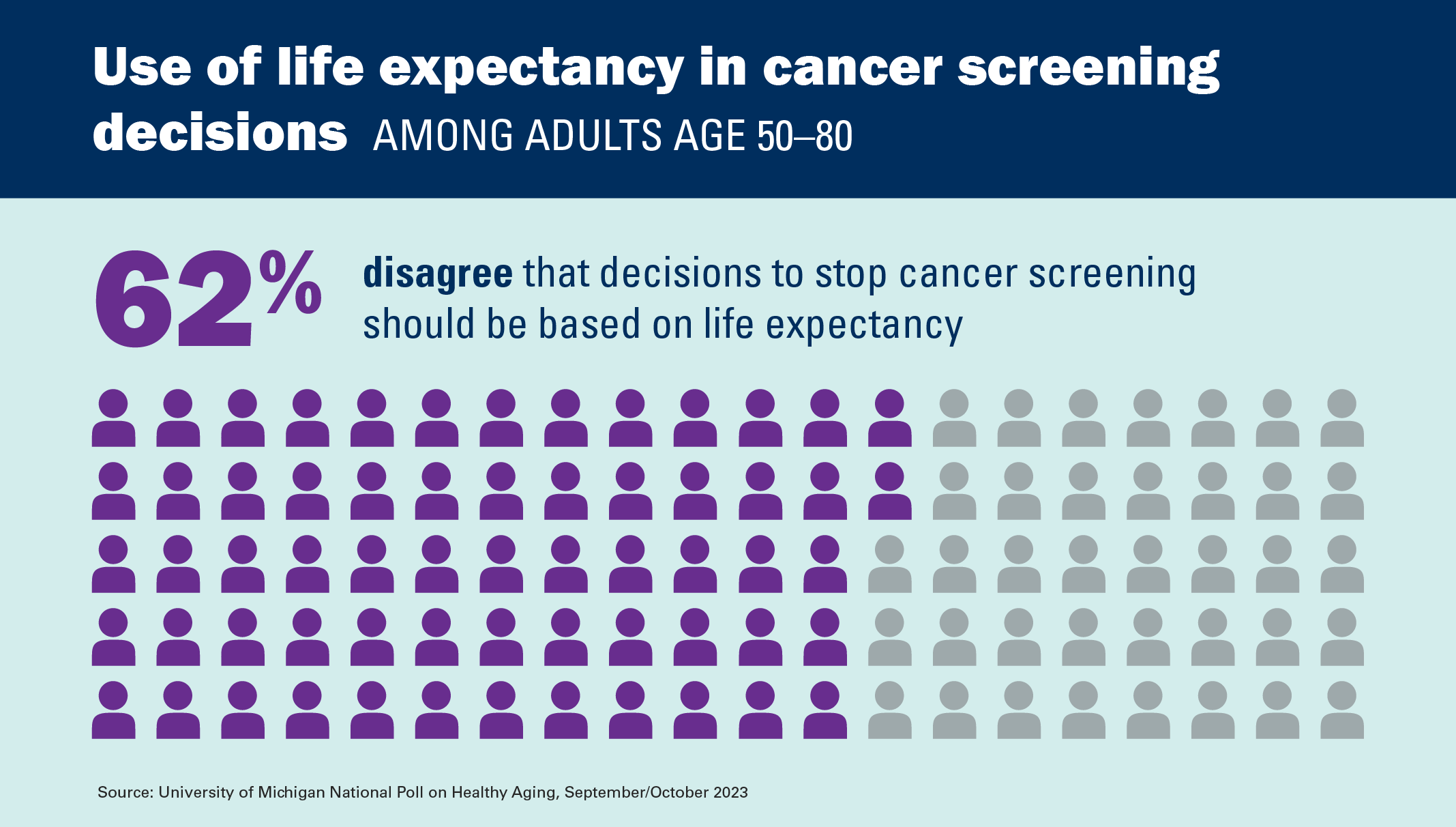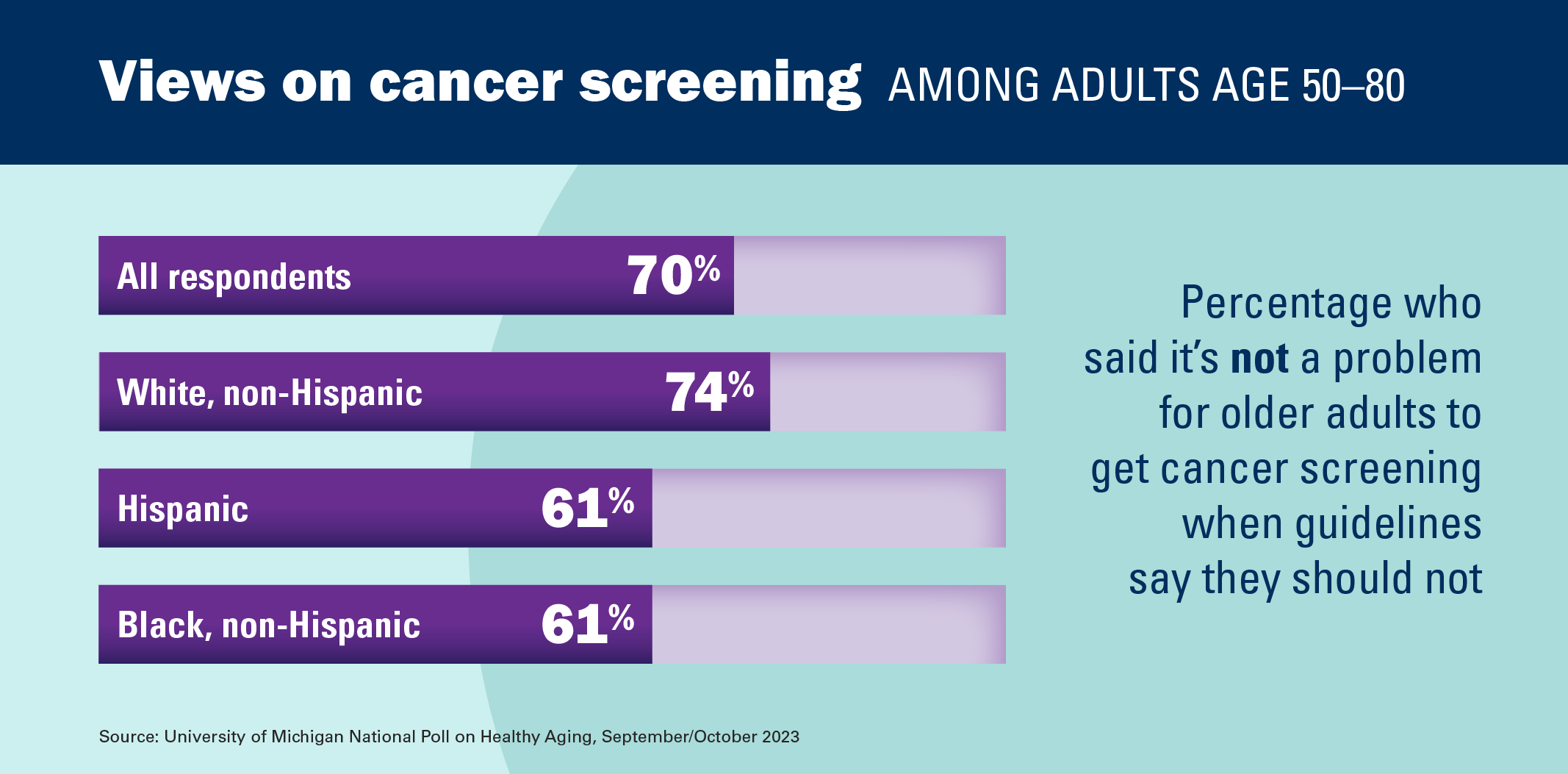
Screening tests are used to identify cancers early enough to treat them, with the ultimate goal of helping people live longer and healthier lives. Most U.S. screening guidelines for different types of cancers recommend ages for when to both start and stop regular screenings. Increasingly, however, screening guidelines are encouraging health care providers and patients to consider other factors in addition to age — such as estimated life expectancy, general health, and past screening history — when making decisions about whether to have cancer screening tests. In January 2023, the University of Michigan National Poll on Healthy Aging asked a national sample of adults age 50–80 about their views on how cancer screening decisions should be made.
Should screening guidelines consider life expectancy?
Over half of adults age 50–80 (56%) disagreed (24% strongly, 32% somewhat) that “guidelines should determine whether someone should CONTINUE cancer screening based on how much longer they have to live,” and 62% disagreed (26% strongly, 36% somewhat) that “guidelines should determine whether someone should STOP cancer screening based on how much longer they have to live.”
Women were more likely than men to disagree that guidelines should use life expectancy in determining the age at which to recommend stopping screening (66% vs 57%). Three in ten women age 50–80 (30%) strongly disagreed and 37% somewhat disagreed with guidelines recommending using life expectancy to stop screening, while 21% of men strongly disagreed and 36% somewhat disagreed with this statement. Strong disagreement was also more common among Black, non-Hispanic older adults (37%) as compared to White, non-Hispanic (24%) and Hispanic (28%) older adults.
All respondents age 50–80 were asked if they believe that a life expectancy of at least 10 years is “too long,” “about right,” or “too short” for deciding whether someone should continue or stop getting cancer screening tests. Overall, 55% of older adults believe the 10-year life expectancy threshold is about right, while 27% stated that the threshold was too short, and 17% said it was too long.

Is it a problem if older adults do not follow cancer screening guidelines?
Seven in ten older adults (70%) said that they do not believe “it is a significant problem that some older adults receive cancer screening tests when guideline recommendations say that they should not.”
White, non-Hispanic older adults, compared to Hispanic and non-Hispanic Black older adults, were more likely to disagree that it is a problem when older adults receive a cancer screening against guideline recommendations (74% vs. 61% vs. 61%). Rates of disagreement on this item were relatively similar between men and women (72% vs. 68%).
Medical maximizers versus minimizers
Respondents were characterized as medical maximizers (people who tend to want to get every kind of test or treatment they are eligible for), medical minimizers (people who prefer to only have tests or treatments that are necessary), or having neutral preferences based on their responses to two validated questions that asked about their preferences when making decisions about medical care. Forty-three percent were characterized as neutral, 37% as medical minimizers, and 19% as medical maximizers.
While 57% of older adults classified as medical minimizers disagreed with cancer screening guidelines adjusting recommendations to stop screening based on long a person is expected to live, more than seven out of ten adults who were classified as medical maximizers (73%) disagreed with having guidelines that use life expectancy to determine when to stop cancer screening.

Implications
Using life expectancy, rather than fixed age cutoffs, to guide cancer screening decisions could help certain older adults to continue to get appropriate cancer screening tests. Continuing to screen for cancer past the age cutoff is most appropriate for older adults who are relatively healthy and expected to live long enough to benefit from further screening.
At the same time, using life expectancy to guide screening decisions could also protect less healthy older adults from overscreening — that is, getting tests that are unlikely to be helpful because their potential harms and risks outweigh their potential benefits. The benefits of cancer screening diminish with age for two reasons. First, even though a screening test could find a new cancer, some older adults may not live long enough for the cancer to affect their health. In fact, most research studies have found that it takes about 10 years for a person to benefit from getting a cancer screening test. For this reason, many cancer screening guidelines recommend that adults who are unlikely to live 10 more years should not receive any more routine cancer screening tests. Second, older adults are more likely than younger people to face risks associated with cancer screening tests (e.g., side effects from anesthesia as part of a colonoscopy, or complications such as bleeding from screening procedures). Considering older adults’ life expectancy in cancer screening guidelines therefore reduces unnecessary cancer screening tests and protects older adults from preventable harms and costs.
A personalized approach that considers life expectancy as part of cancer screening guidelines therefore appears to be a win-win situation. In this approach, relatively healthy older adults, regardless of age, continue to get cancer screening tests they are likely to benefit from. At the same time, older adults with significant health problems also benefit by avoiding getting cancer screening tests that are unlikely to help them and could cause harms. And, as a result, society benefits by more effectively using healthcare resources.
Yet, this poll shows that the reality is more complicated. Instead of embracing the idea of an individually tailored approach to cancer screening guidelines, most older adults disagreed with cancer screening guidelines recommending use of life expectancy either to justify continuing or to justify stopping screening. This disagreement was common among women versus men, which is particularly important to note given that women face more recommended screening tests overall and are more likely to live long enough to reach the age cutoffs stated in cancer screening guidelines. Hence, it will be healthy older women who will most commonly need to consider whether a long life expectancy is a reason to continue receiving cancer screening tests.
Another reason many older adults disagree with guidelines determining when to stop screening based on life expectancy appears to be that many (70%) do not have concerns about receiving extra cancer screening tests, even when screening guidelines recommend not having them. Lack of concern about extra cancer screening tests was particularly common among White, non-Hispanic older adults, a population with the most access to cancer screening tests. It was also particularly true for older adults who hold maximizing beliefs about healthcare (i.e., who want to get all the tests they are eligible for). As a result, older adults are likely to want more cancer screening tests, whether or not those tests actually benefit them.
These poll findings have important implications for cancer screening decision-making between health care providers and patients. Conversations about stopping cancer screening may be uncomfortable. Many people are hesitant to confront the reality that our lifespans are limited and that, at some point, screening tests may not help us live longer, healthier lives. Yet, honest discussions about health status and life expectancy can better inform their decision-making. This poll suggests that an important first step to more personalized care is helping both patients and health care providers understand why life expectancy is relevant to cancer screening decisions, and that there are times when not doing a cancer screening test may be the healthiest approach.
Data Source and Methods
This National Poll on Healthy Aging report presents findings from a nationally representative household survey conducted exclusively by NORC at the University of Chicago for the University of Michigan’s Institute for Healthcare Policy and Innovation. National Poll on Healthy Aging surveys are conducted using NORC’s AmeriSpeak probability-based panel. This survey module was administered online and via phone in January 2023 to a randomly selected, stratified group of U.S. adults age 50–80 (n=2,563). The sample was subsequently weighted to reflect population figures from the U.S. Census Bureau. The completion rate was 61% among panel members contacted to participate. The margin of error is ±1 to 3 percentage points for questions asked of the full sample and higher among subgroups.
Findings from the National Poll on Healthy Aging do not represent the opinions of the University of Michigan. The University of Michigan reserves all rights over this material.
Read other National Poll on Healthy Aging reports and about the poll's Michigan findings, and learn about the poll methodology.
Citation
Zikmund-Fisher B, Singer D, Kirch M, Solway E, Roberts S, Smith E, Hutchens L, Malani P, Kullgren J. Older Adults’ Views on Cancer Screening Guidelines. University of Michigan National Poll on Healthy Aging. September/October 2023. Available at: https://dx.doi.org/10.7302/8638
Laura Brotzman, MPH, a doctoral student in the School of Public Health, also contributed to this report.